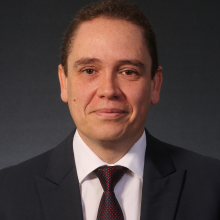EXECUTIVE INTERVIEW: RODRIGO SILVA E SOUZA, Vice President of Marketing, Embraer Commercial Aviation
Click on image to download high resolution version
How have industry players been quick to adapt technology to cater to the changing needs in achieving sustainable goals?
The industry aims to have net zero CO2 emissions by 2050. That’s a huge challenge that requires a huge change in the technologies we use today. It’s fair to say that industry players are moving as fast as possible to enable new technologies to come, but in the face of such a challenge, it will take some time for the changes to really make a difference. Sustainable Aviation Fuels will be one of the main factors in reducing CO2 emissions in the coming years, as well as the replacement of old-generation airplanes with more efficient ones. Embraer is well-positioned to support this transition. Our E-Jets E2 family reduces fuel burn per seat by up to 25% compared to our previous generation E-Jets and we are working to make it compatible with 100% SAF by 2030. In addition to current technologies, we’re studying ways to improve the efficiency of our current aircraft, and to develop different types of propulsion, such as electrification and hydrogen, to power new zero-emissions aircraft.
In which areas and geographies do you see the strongest potential for growth?
We prepare an annual 20-year Market Outlook that estimates world demand for jets and turboprops in the up-to-150 seat category. Our forecast shows that air travel, measured in RPKs, in Asia Pacific and China will grow the most. RPKs will increase 4.4% annually over the next two decades in those regions. Latin America comes next with 4.1% annual RPK growth, followed by Africa at 3.7%, the Middle East at 3.2%, North America with 2.2%, and Europe at 2.0%. The Europe rate excludes the CIS. When you combine all those regions, total global RPKs will reach 17.7 trillion by 2042. And when you look at share, Asia Pacific will account for 42% of global traffic. That’s a massive number compared to Europe and North America combined, historically the world’s largest markets, which will generate 38% of demand. For our up-to-150 aircraft category, we forecast a need for 8,790 jets in that period. What’s driving that demand are traffic patterns favoring short-haul versus long-haul flights. On top of that, there’s increasing need for fleet flexibility, greater connectivity, and operating efficiency. And then you add the transition to more sustainable aircraft types with new technologies to achieve the goals of a decarbonized industry.
What green technologies do you predict will impact the aviation industry most in the next five years?
Clearly, SAF will be the next technology to help reduce CO2 emissions, especially in the short term. Embraer is supporting the Brazilian government in developing new regulations to encourage SAF production in Brazil. We also work with other countries to support the technical discussions and advocacy for the development and scale up of SAF production.
What are your expectations from the Dubai Airshow 2023?
For us, the show is mostly about visibility. We’ll have our E195-E2 in a new livery on display. Over the years, airlines from Egypt, Jordan, Bahrain, Turkey, Kenya, Oman, and Saudi Arabia have added first-generation Embraer E-Jets to their fleets. The Dubai show is a tremendous opportunity to introduce carriers in the region to a completely new version of the E-Jets family. There’s no substitute for physically sitting in the E2, flying on it, inspecting every part of it, and talking to our team to really appreciate all that it can do, and all its new technologies. Our E2s are incredibly economical to operate and they’re incredibly sustainable. We’re hoping our visitors will leave with a whole new understanding of our new E-Jets E2 family.
Lastly, what are Embraer’s plans in the region?
We believe there’s untapped potential to expand intra-regional connectivity. One way to achieve this is with more point-to-point nonstops. Another way is to link hubs with less-dense city pairs. Our E2s are ideal for this – they’ve got the range and operating cost to compete in any kind of market, even low-fare. Both Royal Jordanian and SalamAir recognize this which is why, combined, they recently ordered 14 E2s. We forecast a total potential of over 900 deliveries of aircraft up to 150 seats over the next 20 years.

